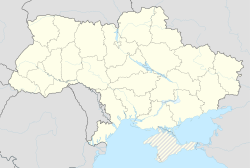Komarno, Ukraine
|
Komarno Комарне / Комарно / Кома́рно |
|||
|---|---|---|---|
| City | |||
|
|||
| Coordinates: 49°37′50″N 23°42′11″E / 49.63056°N 23.70306°ECoordinates: 49°37′50″N 23°42′11″E / 49.63056°N 23.70306°E | |||
| Country |
|
||
| Province |
|
||
| District | Horodok Raion | ||
| Established | 1471 | ||
| Area | |||
| • Total | 10.67 km2 (4.12 sq mi) | ||
| Elevation | 263 m (863 ft) | ||
| Population | |||
| • Total | 3,842 | ||
| • Density | 360/km2 (930/sq mi) | ||
| Time zone | EET (UTC+2) | ||
| • Summer (DST) | EEST (UTC+3) | ||
| Postal code | 81562, 81563 | ||
| Area code(s) | +380 3231 | ||
| Website | місто Комарно (in Ukrainian) | ||
Komárno (Polish: Komarno,(Ukrainian: Кома́рно, Yiddish: קאָמאַרנע) is a city located in Horodok Raion (district) of Lviv Oblast (region) in western Ukraine. Local government is administered by Komarnivska city council. Its population is approximately 3,794 (2017 est.).
It was founded in 1324. In the center of town is an old Polish Kostel (Catholic Church), as well as an old wooden Ukrainian Orthodox church complete with ancient icons. The river Vereshytsia flows through the town.
The Hasidic dynasty of Komarno originates from this town. Komarno, which until the Partitions of Poland belonged to Ruthenian Voivodeship, received its town charter (Magdeburg rights) in the mid-15th century from King Kazimierz Jagiellonczyk. The town was under protection of Voivode Stanislaw de Chodecz, who in 1473 founded here a Roman Catholic church. Komarno was a local center of textile industry. The town was divided into several districts, and remained in private hands of several voivodes. In 1590, it belonged to Jan Ostrorog, the voivode of Poznań, and in the 17th century, it was property of the House of Wiśniowiecki. Later on, Komarno belonged to the Ogiński family, and Lanckoroński family. In the 19th century, when it already was part of Austrian Galicia, the Lanckoroński family built here a palace. Last owner of Komarno was Countess Karolina Lanckorońska.
...
Wikipedia




